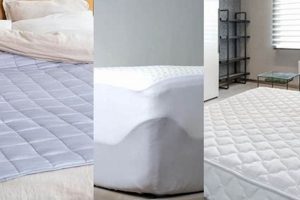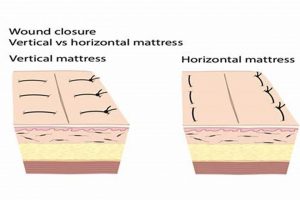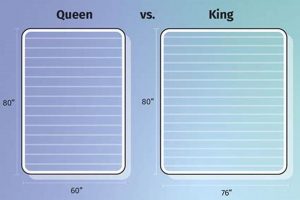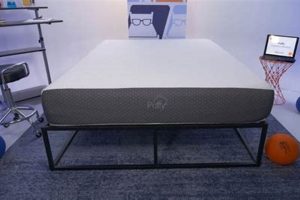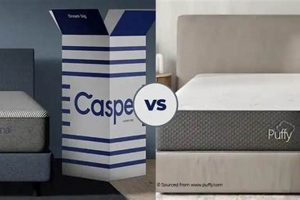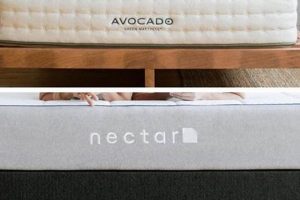The comparison involves two distinct mattress constructions. One employs a core of metal coils to provide support and structure, offering varying levels of firmness and responsiveness. The other integrates this coil system with layers of foam, latex, or other materials to create a balance of support and comfort.
Understanding the attributes of each construction is crucial for selecting a sleep surface that aligns with individual needs and preferences. Factors such as spinal alignment, pressure relief, and temperature regulation are directly influenced by the materials and design of the mattress. Historically, coil-based mattresses were the standard, while layered constructions represent a more recent evolution, aiming to address specific comfort concerns.
The following discussion will explore the core components, advantages, and disadvantages of each type, enabling informed decision-making when choosing a new sleep solution. Considerations regarding durability, cost, and suitability for different sleep styles will be addressed.
Guidance for Selecting a Mattress
The following points offer advice on choosing between coil-based and layered mattresses, focusing on critical factors for optimal sleep and long-term satisfaction.
Tip 1: Assess Individual Sleep Preferences. Evaluate preferred sleep position (side, back, stomach) and desired firmness level. Side sleepers may benefit from the enhanced pressure relief of layered designs, while back sleepers may find the firmer support of a coil-based mattress more suitable.
Tip 2: Consider Body Weight and Type. Heavier individuals may require a thicker coil gauge or denser foam layers for adequate support and durability. Lighter individuals may find softer surfaces more comfortable and conforming.
Tip 3: Evaluate Temperature Regulation Needs. Individuals prone to overheating should prioritize mattresses with breathable materials, such as open-cell foam or natural latex. Traditional coil constructions also tend to promote better airflow than dense foam layers.
Tip 4: Examine Motion Isolation Capabilities. If sharing a bed, consider the motion isolation properties of each type. Layered designs with memory foam or latex typically minimize motion transfer more effectively than coil-based mattresses.
Tip 5: Review Material Composition and Certifications. Research the materials used in construction, paying attention to certifications such as CertiPUR-US, which indicates that the foams have been tested for emissions and durability.
Tip 6: Investigate Durability and Longevity. Coil gauge, foam density, and construction quality directly impact the lifespan. Researching typical lifespans and reading customer reviews can provide insights into long-term performance.
Tip 7: Compare Costs and Warranties. Establish a budget and compare prices across different brands and models. Review the warranty terms and conditions to understand coverage for defects and premature wear.
Careful consideration of these factors will assist in selecting a mattress that delivers optimal comfort, support, and long-term value. Understanding these considerations leads to a more informed purchase.
This guidance lays the groundwork for a comprehensive understanding of these sleep surfaces. The following sections will delve into specific brand recommendations and case studies.
1. Support Core
The support core represents the foundational element in mattress construction, providing primary support and influencing overall firmness. Its design and materials are critical differentiators between coil-based and layered mattresses, impacting spinal alignment and long-term durability.
- Coil Type and Configuration
Coil-based mattresses typically utilize Bonnell, offset, or pocketed coils. Bonnell coils offer a traditional, interconnected system, providing a firm, uniform feel. Offset coils provide more contouring. Pocketed coils, individually wrapped, minimize motion transfer. Layered mattresses often incorporate a pocketed coil system to offer localized support and reduced motion disturbance. The choice of coil type directly influences pressure distribution and the sensation of motion transfer across the sleep surface.
- Coil Gauge and Density
Coil gauge, measured numerically, indicates the thickness of the coil wire. Lower gauge numbers represent thicker, firmer coils, offering greater support for heavier individuals. Coil density, the number of coils per mattress area, influences support consistency. Layered designs may utilize a higher coil count to enhance contouring and reduce pressure points. Selecting the appropriate coil gauge and density is vital for ensuring adequate support and preventing premature sagging.
- Edge Support Systems
Edge support systems, encompassing reinforced coils or foam encasements around the perimeter, enhance stability and expand the usable sleep surface. Coil-based mattresses often integrate thicker edge coils for improved edge support. Layered mattresses may employ high-density foam rails. Adequate edge support prevents roll-off and facilitates ease of entry and exit from the bed. Strong edge support is more typical in coil-based mattresses to prevent the edges from sagging.
- Zoning and Targeted Support
Zoning refers to varying the coil gauge or density across different mattress regions to provide targeted support to specific areas of the body, such as the lumbar region. Both coil-based and layered designs may incorporate zoning to promote proper spinal alignment and reduce pressure points. For instance, a mattress may feature firmer coils in the center for lumbar support and softer coils at the head and foot. This thoughtful design approach optimizes ergonomic support, making this crucial.
The support core significantly impacts a mattress’s ability to deliver proper spinal alignment, pressure relief, and long-term durability. Understanding the nuances of coil type, gauge, density, edge support, and zoning allows for informed selection of a mattress that aligns with individual needs and preferences. The comparison underscores the fundamental differences in how coil-based and layered designs address support and comfort, thereby guiding consumer choice.
2. Comfort Layers
Comfort layers, positioned above the support core, significantly influence the initial feel and pressure relief characteristics of coil-based and layered mattresses. The composition and arrangement of these layers directly affect how the sleep surface conforms to the body, impacting comfort and spinal alignment. In coil-based mattresses, comfort layers typically consist of thinner amounts of materials such as fiber padding, convoluted foam, or a thin layer of memory foam. The effect is a firmer feel with less body contouring. In contrast, layered mattresses integrate thicker and multiple layers of materials like memory foam, latex, gel-infused foam, or microcoils. This construction results in enhanced pressure relief, conforming closely to the body’s contours. For example, a layered mattress with a thick memory foam layer will cradle the sleeper, alleviating pressure points at the shoulders and hips, while a coil-based mattress with minimal comfort layers provides more uniform support.
The practical significance of understanding comfort layers lies in their direct correlation to sleep quality and overall satisfaction. Individuals seeking enhanced pressure relief, such as side sleepers or those with joint pain, may find layered mattresses with substantial comfort layers more beneficial. Conversely, individuals preferring a firmer sleep surface with greater support may opt for coil-based mattresses with minimal comfort layers. The type and density of foam used in comfort layers also influence temperature regulation. Open-cell foams and gel infusions can enhance breathability, mitigating heat retention. For instance, a layered mattress incorporating latex, known for its breathability and responsiveness, provides a cooler sleep experience compared to one solely relying on memory foam.
In summary, comfort layers play a critical role in differentiating the feel and performance of coil-based and layered mattresses. While coil-based mattresses prioritize support with minimal comfort layers, layered mattresses emphasize pressure relief and contouring with multiple and thicker layers. The selection should align with individual sleep preferences, body type, and specific needs regarding pressure relief and temperature regulation. The challenges of material selection involve balancing cost, durability, and performance, ultimately contributing to the overall value proposition of the mattress. This understanding reinforces the broader theme of informed consumerism in the mattress market.
3. Motion Isolation
Motion isolation refers to the ability of a mattress to minimize the transfer of movement from one area of the bed to another. Its importance is heightened when two individuals share a sleep surface, as disturbances caused by one sleeper’s movements can disrupt the other’s rest. The design and materials used significantly influence a mattress’s motion isolation capabilities, offering a key differentiator between coil-based and layered mattresses.
- Interconnected vs. Individually Wrapped Coils
Coil-based mattresses often employ interconnected coil systems, such as Bonnell coils, which tend to transmit movement more readily across the bed. Layered designs typically utilize individually wrapped or pocketed coils. Each coil operates independently, reducing the spread of motion. For example, if one sleeper tosses and turns on a layered mattress with pocketed coils, the motion is less likely to be felt by the other sleeper compared to a traditional innerspring mattress with interconnected coils.
- Foam Density and Composition
The density and composition of foam layers in layered mattresses contribute significantly to motion isolation. Memory foam, known for its high density and viscoelastic properties, effectively absorbs and isolates movement. Latex also provides good motion isolation, although it is generally more responsive than memory foam. Higher density foams generally exhibit better motion isolation than lower density foams. The integration of these materials into layered mattresses effectively dampens movement transfer.
- Layer Arrangement and Thickness
The arrangement and thickness of comfort layers within layered mattresses influence motion isolation. Thicker layers of memory foam or latex provide greater motion absorption. The strategic placement of these materials above the coil system further minimizes the transmission of movement. For example, a layered mattress with a thick memory foam comfort layer above a pocketed coil system offers superior motion isolation compared to a coil-based mattress with minimal comfort layers.
- Edge Support Construction
While primarily intended to enhance edge stability, edge support systems can also impact motion isolation. Reinforced edges can contain movement within the mattress, reducing the likelihood of motion transfer to the bed’s periphery. Both coil-based and layered mattresses can incorporate edge support, but the type and construction influence its effectiveness in isolating motion. High-density foam encasements, often found in layered designs, may contribute to superior motion isolation compared to reinforced coils alone.
Motion isolation is a crucial consideration for couples sharing a bed. While traditional coil-based mattresses often struggle to minimize motion transfer due to interconnected coil systems, layered designs, incorporating pocketed coils and dense foam layers, offer improved performance. The interplay between coil type, foam density, layer arrangement, and edge support collectively determines the extent to which a mattress isolates motion, ultimately impacting the quality of sleep for both individuals.
4. Temperature Neutrality
Temperature neutrality, referring to a sleep surface’s ability to maintain a comfortable sleeping temperature without retaining excessive heat, is a significant consideration when comparing coil-based and layered mattress designs. This characteristic directly influences sleep quality, particularly for individuals prone to overheating or residing in warmer climates. Both types of mattresses address temperature regulation differently.
- Airflow and Coil Structure
The open structure of coil-based mattresses inherently promotes airflow. The spaces between the coils allow for continuous circulation of air, dissipating heat more effectively. This contrasts with denser foam layers that can restrict airflow. Individuals who prioritize cooling may find the increased breathability of a coil system advantageous.
- Foam Density and Composition
Layered mattresses often incorporate foam, such as memory foam, which, by nature, can retain heat due to its density. However, manufacturers mitigate this through the use of open-cell foam, gel infusions, or phase change materials. Open-cell foams have larger pores that allow for greater airflow. Gel infusions draw heat away from the body, while phase change materials absorb and release heat to maintain a stable temperature. The efficacy of these technologies varies across different products.
- Cover Materials and Breathability
The mattress cover plays a crucial role in temperature regulation. Natural fibers like cotton or bamboo tend to be more breathable than synthetic materials. Some covers incorporate moisture-wicking properties to further enhance cooling. Regardless of the internal materials, a breathable cover can significantly improve the overall temperature neutrality of a mattress.
- Hybrid Design Considerations
Layered designs incorporating coil systems can offer a balance of both support and temperature neutrality. The coil core promotes airflow, while the comfort layers provide pressure relief. The specific materials and their arrangement within the layered construction determine the overall temperature performance. Careful selection of foam types and cover materials is essential in maximizing cooling benefits within a layered mattress.
Temperature neutrality is not inherent to either mattress type but is rather a product of design and material choices. While coil-based mattresses offer inherent breathability due to their open structure, layered mattresses can achieve comparable or even superior temperature regulation through the incorporation of advanced cooling technologies. The ultimate selection should be guided by individual preferences, considering the specific materials and design features of each mattress.
5. Durability Expectations
Durability expectations represent a crucial factor in the consideration of coil-based and layered mattresses, significantly influencing long-term value and overall satisfaction. This component dictates the lifespan of the sleep surface, directly affecting the frequency of replacement and subsequent costs. Coil-based mattresses, traditionally, have been recognized for their robust coil support systems, often constructed from hardened steel. This foundational element contributes to resistance against sagging and deformation over extended periods. However, the longevity of coil-based mattresses is also dependent on the quality of the upholstery layers. Thin or low-density padding materials may degrade more rapidly, leading to a diminished comfort level despite the coil system’s integrity. For instance, a coil-based mattress with high-gauge coils but low-quality foam padding may exhibit good support for several years, but the comfort layer could compress and flatten within a shorter timeframe, necessitating replacement or the addition of a mattress topper.
Layered mattresses, while integrating coil systems in hybrid designs, introduce a different set of durability considerations due to the presence of multiple foam layers. The density and composition of these layers are critical determinants of lifespan. High-density memory foam or latex, for example, typically demonstrate greater resistance to compression and degradation compared to lower-density polyurethane foams. However, even high-quality foam can experience gradual softening over time, impacting the mattress’s overall support and comfort. The arrangement and interaction between different foam layers also influence durability. A well-engineered layered mattress will distribute weight and pressure to minimize stress on individual components, thereby extending its lifespan. For example, layering a resilient transition foam beneath a memory foam layer can prevent premature compression of the memory foam, enhancing the mattress’s overall durability.
In conclusion, durability expectations depend on the specific materials and construction techniques used in both coil-based and layered mattresses. While coil-based mattresses may offer inherent robustness in their coil systems, the quality of the upholstery layers is crucial for long-term comfort. Layered mattresses, with their multiple foam components, require careful selection of high-density materials and strategic layer arrangement to ensure resistance against compression and degradation. Addressing the challenges of selecting appropriate materials and construction techniques is essential for achieving desired durability and long-term value in both types of mattresses. Understanding these factors allows consumers to make informed decisions based on their individual needs and budget, ultimately leading to greater satisfaction with their sleep surface investment.
6. Cost Efficiency
Cost efficiency, in the context of mattresses, encompasses not merely the initial purchase price but the total cost of ownership over the expected lifespan. It involves evaluating the balance between upfront expenditure, durability, and long-term performance. Considering cost efficiency is paramount when deciding between coil-based and layered mattress designs, as each type presents distinct trade-offs.
- Initial Investment vs. Long-Term Value
Coil-based mattresses typically present a lower initial investment compared to layered designs. Their simpler construction and readily available materials contribute to a lower price point. However, the long-term value depends on the quality of the coil system and upholstery layers. Layered mattresses, while often pricier upfront due to advanced materials and complex construction, may offer superior durability and enhanced comfort over time. The extended lifespan and reduced need for replacements can offset the higher initial cost. A consumer must consider that the initial price of an innerspring mattress may be less, but the layered alternative might last longer.
- Material Composition and Replacement Frequency
The material composition of both mattress types directly influences their replacement frequency. Lower-density foams and less durable coil systems in budget-friendly coil-based mattresses may necessitate more frequent replacements, increasing long-term costs. Layered mattresses with high-density foams and robust coil systems can withstand wear and tear for longer periods, reducing the need for frequent replacements. It is critical to note that a mattress with a lower price point may have a shorter lifespan.
- Comfort Layer Degradation and Topper Usage
The degradation of comfort layers significantly impacts the overall cost efficiency. Coil-based mattresses with thin comfort layers may require the addition of mattress toppers to maintain comfort as the original layers degrade. These toppers represent an additional expense. Layered mattresses, with their thicker and often higher-quality comfort layers, may maintain their comfort level for a longer period, reducing the need for toppers. The expense of mattress toppers should be considered in the comparison.
- Warranty Terms and Potential Expenses
Warranty terms provide insight into the manufacturer’s confidence in a mattress’s durability. Longer warranty periods often indicate higher quality construction and materials, suggesting a longer lifespan. However, warranty claims may involve shipping and handling expenses, potentially adding to the overall cost. Evaluating the warranty terms and potential expenses is an essential element of assessing the cost efficiency of coil-based and layered mattresses. Warranty terms need to be part of the calculation.
The cost efficiency of coil-based and layered mattresses is multifaceted, encompassing initial investment, material composition, replacement frequency, comfort layer degradation, and warranty terms. While coil-based mattresses may offer a lower upfront cost, layered mattresses often provide superior long-term value through enhanced durability and reduced need for replacements or additional accessories. A comprehensive assessment of these factors is critical for making an informed decision that aligns with individual needs and budgetary constraints. Evaluating these elements leads to a more comprehensive understanding and cost savings.
Frequently Asked Questions
The following addresses prevalent inquiries regarding the attributes and applications of coil-based and layered mattresses.
Question 1: What distinguishes a layered mattress from a coil-based mattress?
A coil-based mattress primarily utilizes a system of metal coils for support, supplemented by minimal upholstery layers. A layered mattress integrates a coil support system with substantial layers of foam, latex, or other materials to enhance comfort and pressure relief. The fundamental difference lies in the complexity and composition of the comfort layers.
Question 2: Which mattress type offers superior support for spinal alignment?
Both mattress types can provide adequate spinal support, contingent upon coil gauge, density, and zoning. Coil-based mattresses offer firm, uniform support, while layered mattresses allow for greater contouring and targeted support through specialized foam layers. The suitability of each depends on individual sleep position and body type.
Question 3: Which type of mattress is more effective at isolating motion?
Layered mattresses, especially those incorporating pocketed coils and memory foam, generally excel at isolating motion. Individually wrapped coils and dense foam layers absorb movement, minimizing disturbance to a sleeping partner. Coil-based mattresses, with interconnected coil systems, tend to transmit motion more readily.
Question 4: Which mattress type is better suited for individuals prone to overheating?
Coil-based mattresses, with their open structure, promote airflow and dissipate heat more effectively. Layered mattresses can mitigate heat retention through the use of open-cell foams, gel infusions, or breathable cover materials. Selection should consider the specific materials and technologies employed to enhance temperature neutrality.
Question 5: What is the expected lifespan of each mattress type?
The lifespan of both mattress types depends on construction quality and material density. Coil-based mattresses may last for 7-10 years, while layered mattresses, particularly those with high-density foams and robust coil systems, may last for 8-12 years or more. Maintenance practices and body weight also influence longevity.
Question 6: Are there specific advantages to a layered construction for individuals with back pain?
Layered designs can offer enhanced pressure relief and contouring, which may benefit individuals with back pain. Memory foam and latex layers conform to the body’s curves, reducing pressure points and promoting spinal alignment. The suitability of a specific mattress depends on the cause and severity of the back pain.
These responses offer clarity on essential aspects of each mattress type. Careful evaluation of individual needs remains paramount.
Transitioning to practical maintenance techniques enhances the longevity and performance of either choice.
Innerspring vs Hybrid Mattress
This exploration has delineated the core characteristics of these two mattress types, focusing on support systems, comfort layers, motion isolation, temperature neutrality, durability, and cost efficiency. Coil-based mattresses offer a firmer, more responsive surface, while layered designs prioritize pressure relief and contouring. The ideal choice depends on individual preferences and needs.
The decision to purchase a specific type of mattress necessitates careful consideration of these factors to ensure optimal sleep quality and long-term satisfaction. Future advancements in materials and construction techniques may further blur the lines between these categories, offering consumers an even wider array of options. Continued research and informed decision-making are vital for selecting a sleep solution that best aligns with individual requirements.


